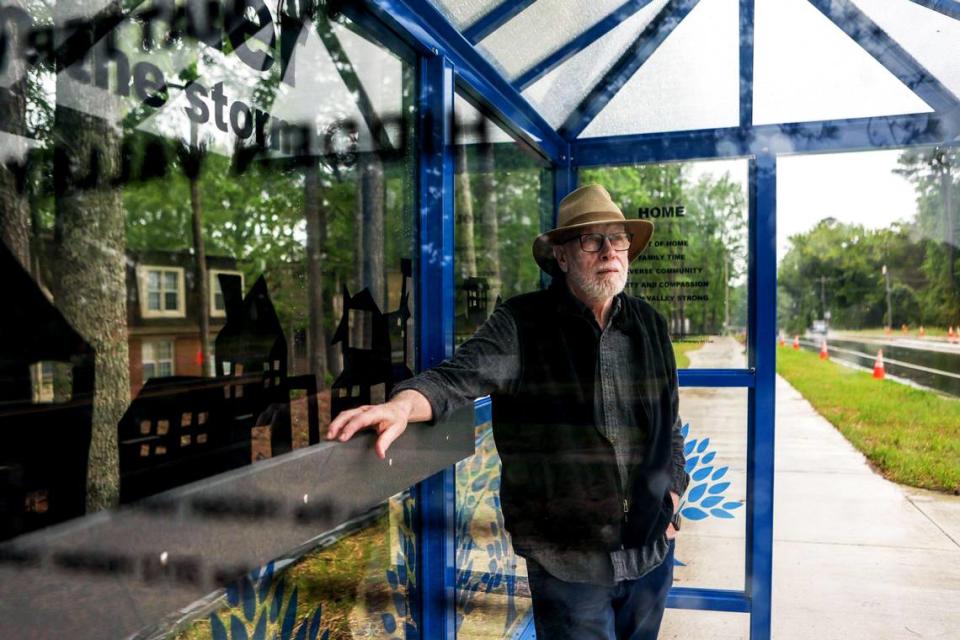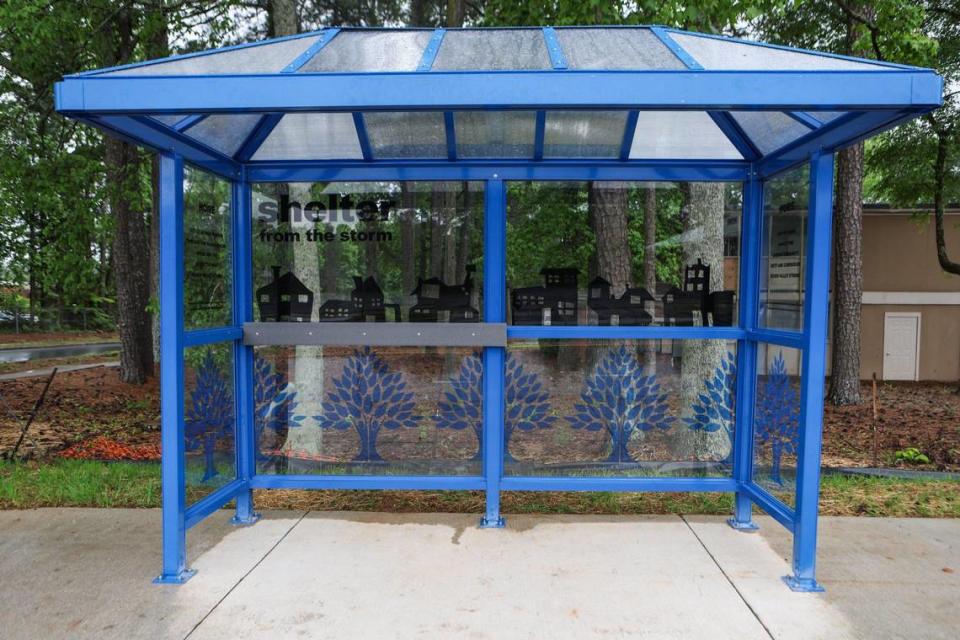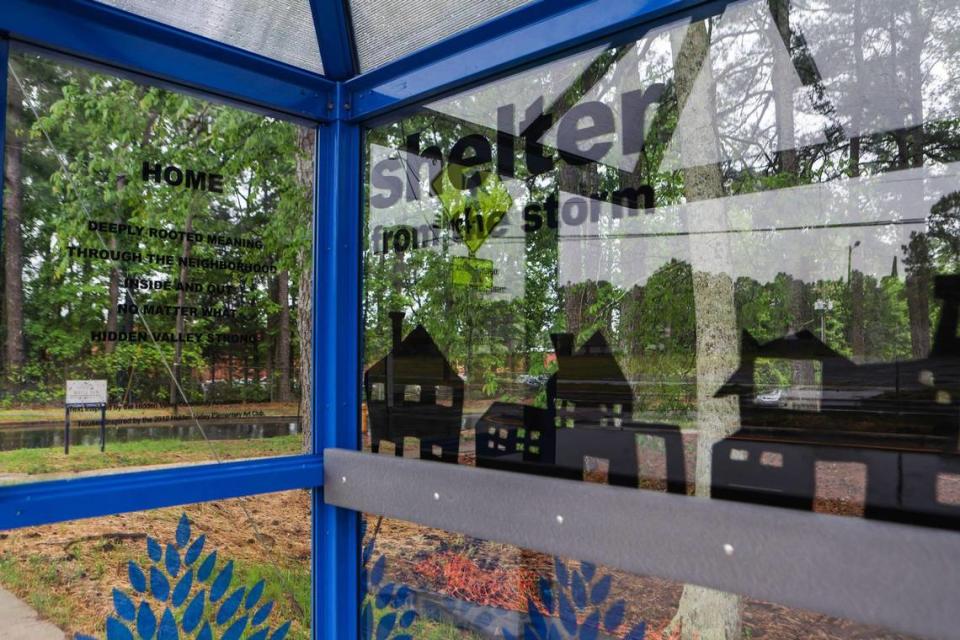An artist and a former student reconnect in Hidden Valley for new bus shelter project
Just in time for summer, people waiting for the CATS 211 bus through the Hidden Valley neighborhood of northeast Charlotte will now be able to wait under a pair of shelters designed, in part, by one of their own.
Unique Patton grew up in Hidden Valley and is a Julius L. Chambers High grad. She recently graduated from N.C. State with a design studies degree, and teamed up with N.C. visual artist Tom Stanley for the bus shelter project.
But it’s not their first artistic partnership.

A friendship in art emerges
Patton’s mother valued arts and culture, and often took her daughter to explore Charlotte institutions like the Mint Museums, the Gantt Center and the annual Festival in the Park.
In the fall of 2012, Patton was just a middle school kid looking to create some art after school.
Her school, Martin Luther King, Jr. Middle, had a partnership with Communities in Schools, a nonprofit that provides resources to schools across the country, and offered an after-school art program. “My mom thought it would be really good, and they provided transportation for students back home, so that was a huge plus,” Patton said.
Stanley is a veteran visual artist who chaired the Fine Arts Department at Winthrop University for a decade. CATS had commissioned him to work on a public art installation for the Tom Hunter Station along the LYNX Blue Line, which served Hidden Valley.
To gain insight into the predominantly Black and Hispanic community — and trust from its members —Stanley began attending Hidden Valley Community Association meetings.
He also decided to head into the schools. “I like to work with children and let them inspire me with ideas,” Stanley said.
Patton was one of the students who worked on the project. “We thought it was really cool how someone who’s not from the neighborhood wanted to get our perspective instead of just designing something about a place but knowing nothing about it,” she said.
Stanley asked the students to create poetry or stories that described how they saw their community.
Themes of pride and joy came up a lot. With that input, and insight from students at Hidden Valley Elementary, Stanley created silhouettes of homes, accompanied by the students’ words.
Finally, in March 2018, the project was revealed.
“I felt very proud when it happened,” Patton said. “When I’m in Charlotte, I take the LYNX almost every day, and it’s been a part of my daily commute in some instances. So it was nice to be able to say that I actually helped design it.”
A community need inspires a new project
In 2019, Stanley received a commission from the Arts & Science Council for another project in Hidden Valley. After watching a short video about the first project, he was inspired by Patton again.
“I had known her when she was in middle school. So I Googled her name and found that she was a senior (in high school) and had won an award for aesthetics and the built environment,” Stanley said. “She was very enthusiastic and said something in the video like, ‘Maybe I can be an artist someday, too.’ ”
Stanley asked if she’d join him once again as a community design liaison. Patton said yes.
Initially a project dealing with signage related to the Tom Hunter Station and Hidden Valley, Stanley shifted focus when he saw for himself one of the community needs.
“There were two bus stops in Hidden Valley,” he said, and neither had a shelter. “We’d see people waiting at the stops sitting on a trash can or waiting in the sun for the bus.”

So their project was able to tap into city funds designated for public arts pieces, and was able to bring shelters to the two bus stops.
The public art on those shelters would come from Stanley and Patton. They decided on a design that would incorporate windscreens and benches, and called the project “Give Me Shelter.”
As community liaison, Patton’s focus in part was to combat the neighborhood’s often negative image. Stanley and Patton set out to learn and show the other side of Hidden Valley.
“I got to talk to people and go to the neighborhood association meetings, and really understand what they’re going through and the problems that they’re having,” Patton said. “We wanted to see how we could make something visual and, at the same time, useful.”
One of Patton’s favorite interviews was of her next-door neighbor, a woman who gave Patton her first job — rolling her trash out to the curb — and who has since passed away. “Being able to talk to her about the stories of her growing up in the neighborhood and her background,” Patton said. “I enjoyed those moments a lot.”
The silhouettes of homes from the original Hidden Valley Elementary School light rail project are featured on the bus shelter, and the tree used in the design was inspired by the community association’s logo.
The shelters are on Tom Hunter Road at Canterwood Road and Monteith Road, and were installed about a month ago.
“Together during rough times,” “unity unbreakable,” and “Hidden Valley strong,” are just a few of the sentiments they collected.
“Our goal was not to make something about us as artists, but to involve community images and words in this public art project,” Stanley said. “We wanted to do something for the community.”

“I really hope that people read the words that we have on the glass panels, because rarely do we get to hear about other peoples’ perspectives and experiences,” Patton said. “I hope the words will come to life through the people who they may see and get a better view of the neighborhood.
“And I also hope that the community members can even take even more pride in efforts to try to make the neighborhood a better place.”
More arts coverage
Want to see more stories like this? Sign up here for our free “Inside Charlotte Arts” newsletter: charlotteobserver.com/newsletters. And you can join our Facebook group, “Inside Charlotte Arts,” by going here: facebook.com/groups/insidecharlottearts.

